Gray Diamonds: More Than 50 Shades Of Gray | Rare Carat
More Than Fifty Shades: Getting to Grips with Gray Diamonds
I was at an adorable street market on Saturday. You know, those ones with the cupcakes and the crafts and the warm cider? Yup, that sort. I had a wonderful time, mostly because I had three alcoholic beverages (all delicious), two cupcakes (one delicious, one forgettable) and brisket sandwich (insane). And half a pretzel. OK a full pretzel, what’s your problem? Stop food shaming me. I’ll shovel what I damn well please in my mouth and nobody can stop me. Anyway, while I was at said market, I saw a framed picture of a quote that went something like;
Don’t define your world in black and white, because there is so much hiding amongst the grays

A few important questions came to mind immediately. Are they selling the quote or the frame? Why would you buy a framed quote? You could just like, print one off if you really wanted it, right? And if they are selling the frame, what happens to the quote after someone buys it? Do they keep it or throw it away? Do discarded quotes cease to have meaning? An existential crisis ensued as I comforted myself with the second half of the pretzel. What the whole affair did remind me of though, is that the quote was on to something; there is certainly beauty to be found in the grays. Especially if that gray is associated with a big fat diamond. So, I got home and immediately decided to write about gray diamonds - partly to educate you, and partly to ask the legit question about discarded quotes. All answers welcome (rian@rarecarat.com). Now shall we learn about gray diamonds?

That's the Spirit!
Where Do Gray Diamonds Come From?
When they are beginning their epic journey all the way down in the earth’s crust, all diamonds aim to come out as pure and colorless as possible. But as they are being created under crazy amounts of heat and pressure, well sometimes other elements can turn up and add some color (and inclusions) into the mix. It’s a bit like me trying to keep to my diet, only to succumb to a cupcake or two… and a brisket sandwich. And a pretzel. Sometimes, life just happens, amiriiiight?! Anyway, as diamonds are forming, they often times interact with other things, and these other things cause the structure and the color of the stone to change.

What’s more, different elements can cause a diamond to take on different colors, creating an assortment of stunning fancy color diamonds! For instance, pink diamonds and red diamonds are caused by a super rare deformity in how the diamond crystals themselves are forming under intense heat and pressure. Yellow diamonds are the result of a large dose of nitrogen present when the diamond is naturally forming. In the case of gray diamonds (and blue diamonds too), they mostly appear due to increased levels of hydrogen or boron in the earth as the diamond is going about its diamond business. Here is a handy chart to show you the effects:
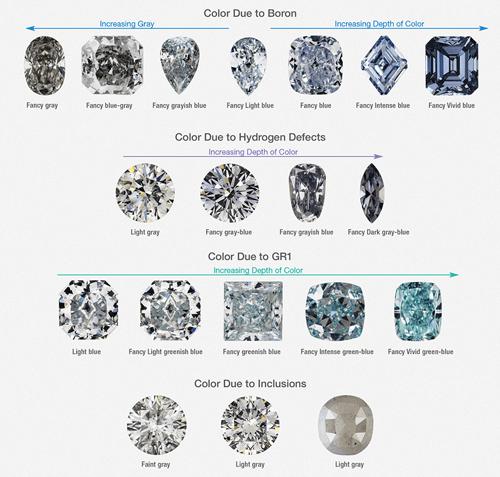
Gemologists tend to refer to these color changes as ‘defects’, but honestly I prefer the term ‘happy mistakes’, because in many cases they can make a diamond even more beautiful! Unlike my bum after the cupcakes, and I’m brave enough to admit that.
So, are all Gray Diamonds Created Equal? In a word, no. You see, the amount of gray in the diamond will depend on how much the hydrogen (or boron) has managed to interact with the diamond as it was going on its merry way. To put it another way, the amount of hydrogen/boron in the diamond will actually affect the hue, tone and saturation of the gray color. Sound confusing? Let’s break it down together, starting with ‘hue’.
Hue:
Put simply, hue is just the shade of color a diamond can have. You can get different colored fancy diamonds, with different ‘hues’ like red, blue, green, purple etc., but white diamonds can have hues too! For instance, the diamonds that you see on Rare Carat and in your local jewelry store will all have a certain hue to them, even if they appear mostly white/colorless. As you move along down the color scale for diamonds, more ‘hue’ is visible. In most cases this hue tends to be yellowish, and that is reflected in the many different color scale images out there, like this one:

Getting More Yellow, That Huey Fellow!
What is super important to know as a soon-to-be diamond buyer however, is that yellow is NOT the only ‘hue’ a diamond can have! Now remember, we are not really talking about fancy colored diamonds here (like vivid pinks and blues), but rather white/colorless diamonds with a hint of color to them (but in now way could be classified as colored diamonds, catch my drift? So, these colorless diamonds can have four different basic ‘hues’; yellow, brown, green and gray:
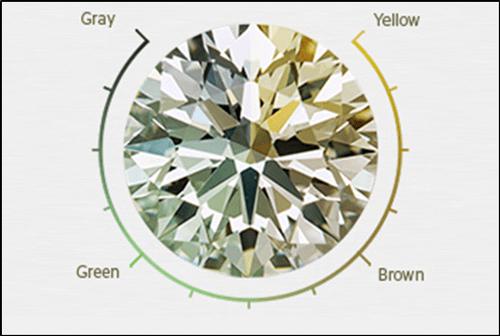
Obviously then, if you want to buy a diamond that is as close to colorless as possible, you want as little hue (of any type, be it yellow, brown, green or gray) as is financially viable for you (knowing that the less color in the diamond the higher the ticket price). If you were buying a legit colored diamond (like a bright yellow or pink) then the opposite would be true; you would want as much hue in that baby as you could possibly afford!
Saturation:
The saturation of a diamond’s color basically refers to the intensity of the hue color found in the diamond. Think of it this way: If I drop a few drops of blue food coloring into a glass of water which is only filled 1/3 of the way, the water will turn blue (obviously, it’s science you fool). Now if I add more water to the glass, the base color will remain the same (i.e. blue from the dye, it ain’t turning yellow all of a sudden), but the concentration of that color will diminish as I add water. The less water, the more concentrated the hue, the more water, the more diluted the hue. YAY SCIENCE!
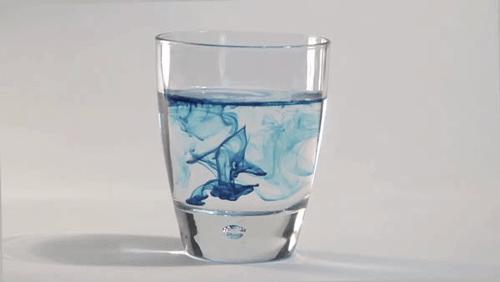
Tone:
Finally, ‘tone’ just refers to how light or dark the diamond appears. Let’s go back to our glass of blue water (yay, science!) and imagine that I mixed a teeny bit of black food coloring in there with the blue. The hue would still be blue (the original color), the saturation would stay the same (how diluted/concentrated that hue is, but it the water would now be darker in tone.
For some of you I know this sounds like far too much in the way of details, and you only came here to learn about gray diamonds. You don’t care about hue! You don’t give AF about saturation! And the only tone you care about is the one in your printer! I get it, but believe me when I say that it’s important to know about these things, because they will help you identify the types of gray diamonds should you come across them on your travels. Here’s why:
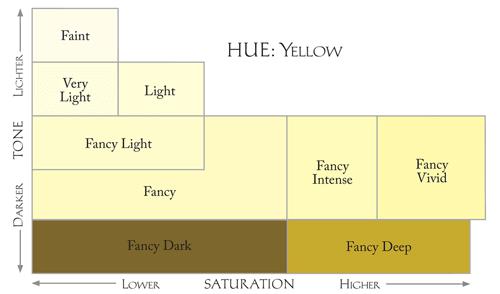
As you can see above (OK the example if for ‘yellow’ hue but you guys can use your damn imaginations and picture gray instead… gimme a break), the lighter the tone and the lower the saturation, the fainter the color found in the diamond. By contrast then, the darker the tone and the higher the saturation, the deeper and more vivid the color will be in the diamond. In fact, the deeper and more vivid the color gets, the more it moves out of the ‘white/colorless diamond with a hint of color’ realm, and in to the ‘fancy colored’ diamond realm. Here’s another visual example so you can see the transition:
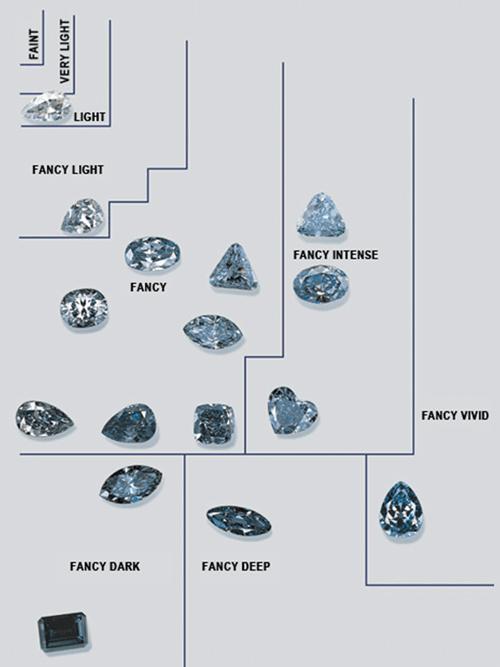
Grey diamonds are classified in the same way, and have different intensity levels when it comes to their color:

Gray Diamond Hue Intensity Chart
Above we can see the official terminology of these different shades of gray diamond; faint gray, very light gray, light gray, fancy light gray, fancy gray, and fancy deep gray. I like to think of these as the very first, and lowest rungs on the ‘fancy color’ diamond ladder. What is important to see here though (and it’s especially visible in the previous image) is that the gray diamonds sitting in between the ‘faint gray’ to ‘light gray’ color band are not considered to be ‘fancy’ colored diamonds, even though they show a fair amount of color (i.e. they have a distinct hue and a little bit of saturation/tone). They only qualify as ‘fancy’ once they have a certain amount of saturation and tone in them. Look at this ‘fancy’ colored stone for instance:
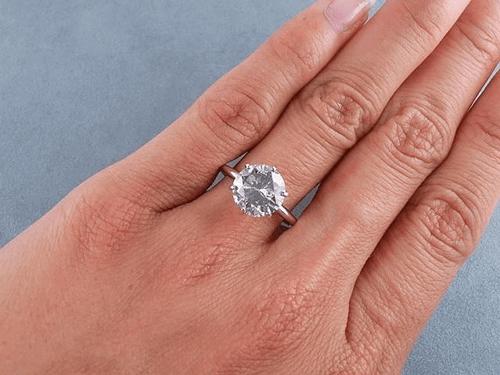
This is Actually Classified as a Fancy Light Gray Diamond
Color Grading Gray Diamonds:
Now that we understand what ‘hue’ ‘saturation’ and ‘tone’ mean, let’s take a look at how these factors actually determine the color grade of our hypothetical gray diamond. If you take a peek at the chart below, you will notice that once a gray diamond hits the ‘K’ – ‘M’ color range, we start to see the stone hitting that first rung of the fancy color ladder (although we know that they don’t even begin to qualify as ‘colored diamonds’ at this stage). Moving on down lower on the color scale, the diamond moves up one more rung on the ‘fancy color’ diamond ladder. In other words, the further along the diamond gets on the traditional color chart (i.e further away from ‘D’ color) the closer it gets to qualifying for ‘colored diamond’ status.
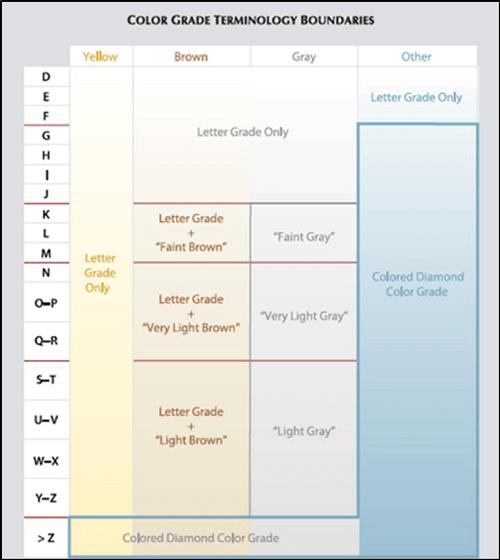
So, what might this look like on a diamond grading report (the certificate that comes with the diamond)? Well, diamonds in the ‘K’ – ‘M’ color ranges with gray color hue, will not actually receive a letter grade (i.e. it will not be identified as a ‘K’ color or an ‘M’ colored diamond as it would be if the hue was yellow), but instead it will simply be assigned the correct terminology such as ‘Faint Gray’. Take a look at this actual diamond report to see what I mean:
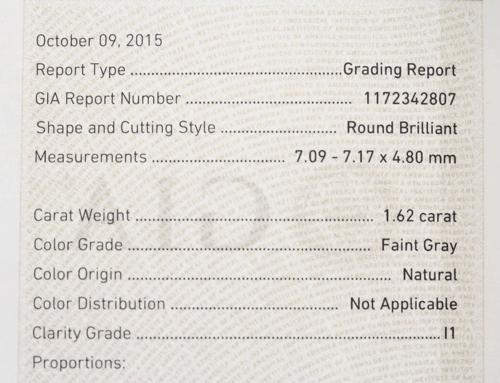
Fifty Shades of Faint Gray
Now that we are experts in the world of diamond hue and color, we know that this ‘faint gray’ color grade means that the diamond hits in the ‘K’ – ‘M’ color band. If it said ‘Very Light Gray’ we would know it was in the ‘N’ – ‘R’ color band and so on. Simple right? NOT SO FAST! Did you notice anything strange on that chart? Go back and take a look at the ‘D’ – ‘J’ section in the gray diamond classification…. YUP. That’s right, if a diamond is given a color grade of between ‘d’ and ‘J’ – even if there is a gray hue – it will not be stated on the report. Crazy right? The same applies to our other base hues for colorless diamonds (green, brown and yellow). If the color grade is high enough (closer to colorless), they will not bother to state the color hue. So, you could have a ‘J’ colored diamond with a gray hue and the only way you will know is by taking a good hard look at the stone, either in a video/photo or better yet, in person.
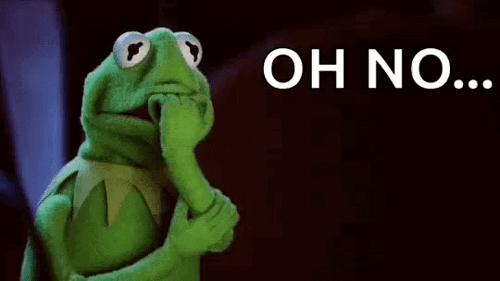
Fear not. This is not the time to panic and rule our gray color diamonds! Quite the opposite actually. You see, gray diamonds can actually be a brilliant choice for an engagement ring because, unlike brown diamonds (those near-colorless diamonds with a ‘browner’ hue) or green diamonds (those near-colorless diamonds with a ‘greener’ hue), the gray hue really works well at keeping that steely ice look of the colorless diamonds. Take a look at this ‘Fancy Light Gray’ to see what I mean:
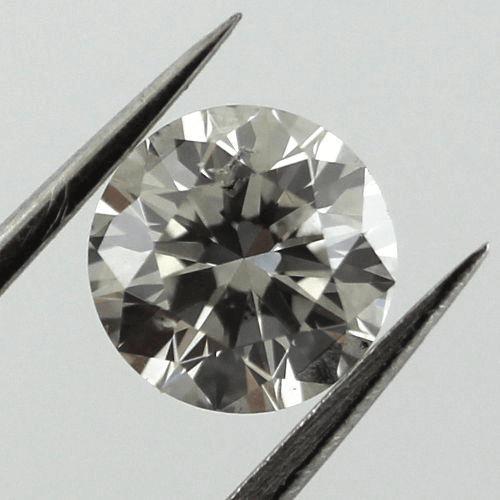
And just so that you can get a feel for how little the gray hue actually impacts the overall look of the ring, take a look at this ‘Faint Gray’ diamond set in a simple white gold band (it would look just as stunning in a yellow gold band mind you):
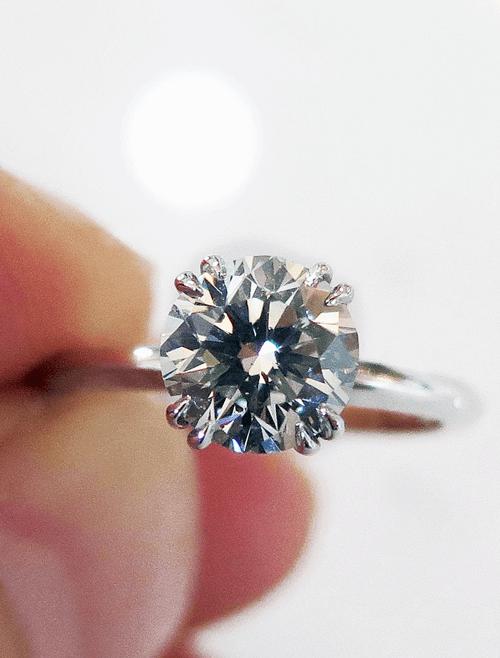
I Might FAINT from The Beauty of this Gray Diamond Engagement Ring
The bottom line here guys, is that embracing a hue other than yellow, especially gray, can reduce the cost of the diamond (because yellow hue is the most popular and recognizable – therefore the more expensive) without compromising on the beauty of the stone itself. And If you are choosing a diamond that sits in the ‘D’ – ‘J’ color bracket, just remember that the hue of those stones will not always be yellow, and that it will not be stated on the diamond grading report. You will need to ask the retailer or indeed take a close look yourself in order to spot the gray undertones in the diamond. However, we think that if you keep an eye out for a gray hued diamond and you will not only end up with a bargain (gray hues will be less costly than yellow, all else being equal), but also with a diamond engagement ring that has something very different and special about it.

I'll Take It


Gray Diamond FAQs